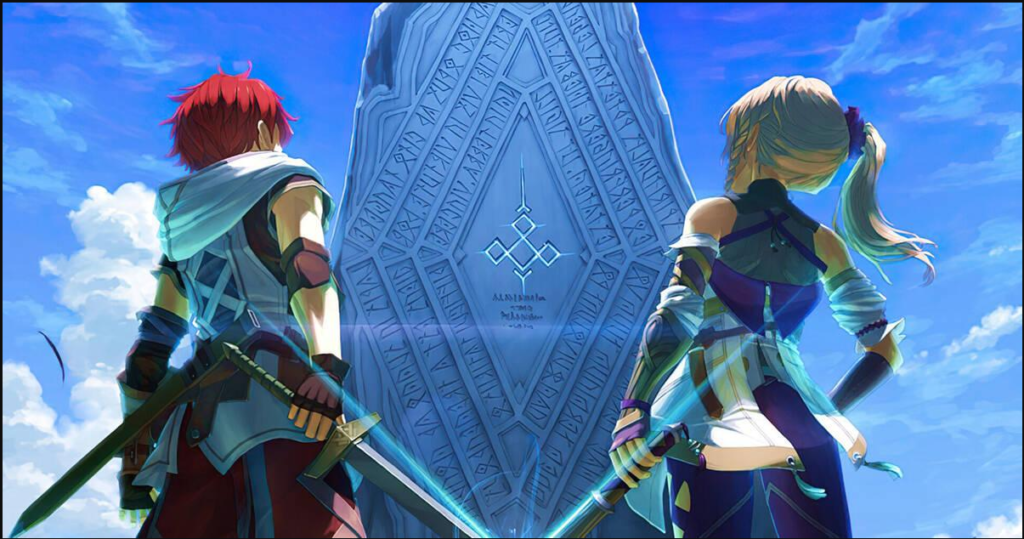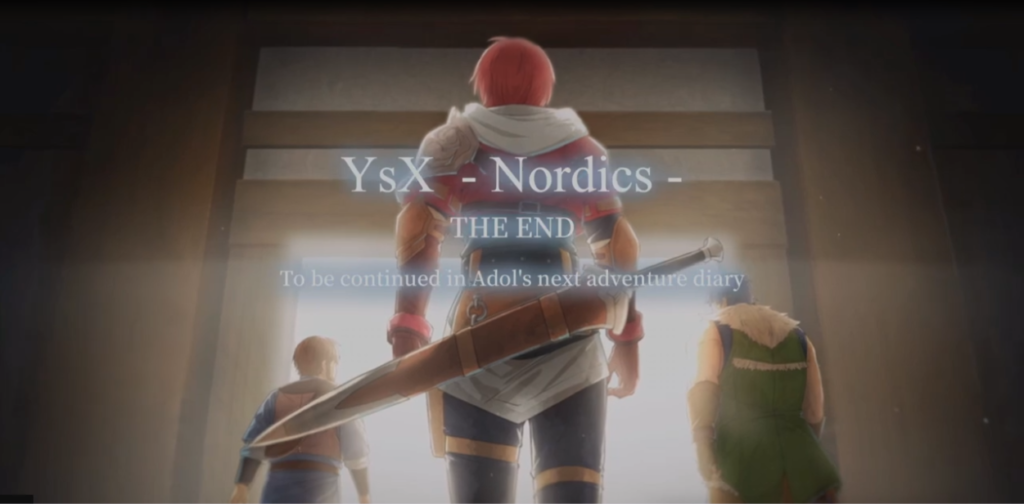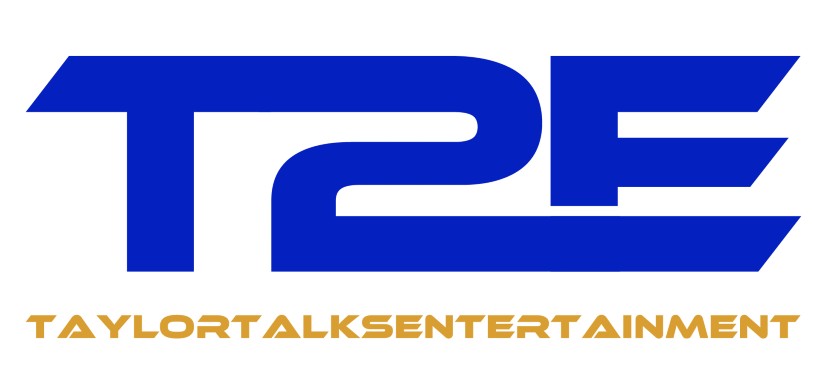In the Western world Falcom fans have had no shortage of things to latch onto this year as 2023 marked the localized releases of Trails Into Reverie as well as The Legend of Nayuta. But 2023 also marks the 35th anniversary of Falcom’s most iconic property, the one and only Ys. Naturally, we got a Nintendo Switch port of the Ys 3 remake, Oath in Felghana as well as the release of a special music compilation honoring the entire history of Ys. But more than all of that we saw the release of the latest installment in the franchise; Ys X: Nordics. It had been four years since the release of Ys IX: Monstrum Nox, so fans of the red-haired adventurer were no doubt excited to see his return. And with this being the first Ys game developed entirely in Falcom’s new development engine, expectations were high. Does Nordics measure up to the legacy of the series? Does it charter a new course for the franchise? Let’s dive in and find out. This is Ys X: Nordics!

Introduction & Leadup to Release
Now, since this is the first time I have covered this franchise here at T2E, some of you may be wondering what Ys is as well as how it’s pronounced. Legend of Heroes is often the series of games you think of when modern Falcom comes to mind. However, near the dawn of the company itself in the ‘80s, action role-playing games were relatively unheard of. Falcom created what was clearly not the first, but one of the frontrunners of the whole genre. The original Ys was released in 1987 for a variety of systems and was one of the first of its kind in which players wander a wide world, battle enemies, gain experience and items, all in real time.
The name itself comes from the mythical land of Ys, the setting of the original duology. Players enter the role of Adol; a wide-eyed red-haired adventurer who finds himself at the heart of a grand adventure. Adol was largely mute, which further allowed players to imagine themselves in the role and help with immersion. And Ys sets itself apart from many other long-running franchises in the sense that it follows the same character from one installment to another. And Falcom saw the franchise potential, hence the framing device. The story of Ys is the adventures of Adol as told through the travel diaries he kept of his various adventures. The stories carry over ideas, themes, and characters over the course of the larger series whilst telling stories that are accessible and digestible to a larger audience, which is a distinct advantage over say the Legend of Heroes franchise. In layman’s terms, Ys has always been Adol’s story of traveling across an allegory of a fantasy-based Europe with real life inspiration drawn from its locations. The franchise has always placed an emphasis on Adol’s friendly and adventurous spirit as well as the connections he forged over his life in an era of exploration.
Nordics saw its domestic Japanese release for PlayStation 4, 5, and Nintendo Switch on September 28, 2023. Many in the base likely raised eyebrows at the set timeline as this game is set directly after the events of Ys 2. This came directly after the release of Monstrum Nox, which made an effort of showing us the oldest iteration of Adol that we had ever seen at this point, at age 24 to be specific. But now all of a sudden were going back to 17-year-old Adol. Some, me included, were worried about this limiting the scope and scale of Nordics given that Adol has to be in Memories of Celceta starting position by the end of this tale. Naturally, Falcom addressed this in an interview claiming that making Adol younger again was definitely an attempt to appeal to younger audiences. Later on we’ll dive into whether or not this was a success. Similarly, Falcom made an extensive effort to appeal to that audience as they developed an in-house port for the Nintendo Switch, which is a significant demographic in Japanese domestic markets, as opposed to focusing on Sony platforms and allowing their partners and Western publishers such as Clouded Leopard Entertainment and Nippon Ichi Software of America respectively.
Synopsis & Writing

The story is set directly after the defeat of Darm in Ys 2 and Adol has joined up with good friend and new travel companion Dogi as they plan to escort Dr. Flair to Celceta. However, before the trio can do so they find themselves under attack by Baltan’s Army and Navy whilst passing through Obelia Bay in the Northern Sea. It is here that our young adventurer meets Carja, an experienced warrior and officer of the Baltan Army. What seems like a chance encounter for the pair is actually a deeper machination that will forever change the world for the both of them, as they embark on a grand tale that they weave together.

Nordics wastes no time in establishing its critical players and settings. The residents of Obelia Bay are certain to become memorable staples of the franchise and Carja herself, in addition to being well developed, has an exceptionally strong character introduction that immediately endears her to the player. With the pair being figuratively and literally linked together, the dynamic between Adol and Carja is one of the driving forces of the narrative, and as such we learn a lot about her and her people, the Baltans. It would have been very easy for Falcom to write a transitionary story that rings largely irrelevant with no impact on the larger series. But the plot and characters of Nordics earns its place in the franchise’s storied history and gives us some characters who cement themselves as memorable staples of the series.
Nordics gives us plenty of new characters to get to know, but also reintroduces us to some series staples that we haven’t seen in some time. Dr. Flair, despite being introduced in Ys 2, is given probably his largest amount of screentime since his introduction outside of the original iteration of Ys IV: Mask of the Sun. His involvement serves to link the series’ past with the present and gives modern recognition to the events of the original duology.
Similar complements extend to series veteran, the former bandit Dogi. Despite being featured in nearly every iteration of the franchise, we’ve never really explored the dynamic between Adol and Dogi at this point in time when the pair had just begun traveling together. Some fans may take issue with him once again being relegated to a member of the supporting cast, but his presence serves to reassure the player and offers a deeper insight into Adol and Dogi’s relationship.
One can’t speak of Ys without mentioning its protagonist Adol Christin. The young man has seen many adventures and continues to be the heart and soul of the series. As his boundless optimism and adventurous spirit remain intact, the setting of Nordics allows for unique opportunities in his characterization as he has just liberated the land of Esteria and Ys from the likes of Dark Fact and Darm. He may have one adventure under his belt, but he is still very young and relatively inexperienced in comparison to future installments. As such, he has a level of confidence and eagerness that might seem rash by later installment standards. But his charm has never been higher, and he is voiced to perfection by Yuki Kaji who has voiced him in Japan since the Ys 4 remake Memories of Celceta when he replaced longrunner Takeshi Kusao. Kaji’s performance marvelously evokes that adventurous spirit and is infectious with all its energy.
Falcom has always taken real world influences of the cultures and locales portrayed in settings across the series. From the not so subtly named Romn Empire taking cues from the Romans to this game’s title Nordics drawing heavy inspiration from Norse mythology and culture, with the Baltans being heavily inspired by the Vikings.
The narrative of Nordics is beautifully conceived and stands out as one of the more thematically loaded narratives in the series. As someone who was rather worried about going back in the series timeline, Nordics pleasantly surprised me and earned its place in the franchises’ well decorated history.
Gameplay
Ys as a series has for decades remained in people’s consciousness, not only for its engrossing storylines but also its novel gameplay. Since the very beginning Ys has been an ARPG at its core. From the humble beginnings of bump-style combat in Book 1 &2 , to the explorative Ark Trilogy, to the Seven engine games and beyond. Nordics elects to leave behind the era of Seven through Nine, which puts an emphasis on switching between characters and attack types in order to navigate different enemy types. We no longer travel in parties of three. You will play exclusively as protagonists Adol and Carja. You can still switch between them with the use of a single button.
On-the-ground gameplay is divided into two distinct modes. You can have the pair attack independently and use various skills not dissimilar to the style of the Seven era. But the other mode is unison mode in which Adol and Carja will attack a foe in perfect sync and are able to execute team attacks. Leaving behind party-based combat surely must have been a difficult decision for Falcom, but what they have delivered focuses less on gimmicks and delivers something more refined. Falcom kept all the good parts of the Seven styled RPG and got rid of the factors that dragged it down. New features such as the mana abilities serve to aid you in your exploration but also have combat functionality. The mana hook for example can be used at designated points for platforming based sections. But it can also be used on any enemy you come across to extend your combos.
You might have noticed by this point that at the start of this section I said on-foot gameplay, because Nordics is more than that. For the first time in the series we have non-traditional combat mechanics in a Ys game, specifically naval combat. Putting aside Adol’s over exaggerated history with boats, this was something that could have easily come off as a gimmick filled addition that players dread. But thankfully Falcom put just as much effort here as they did in ground combat. Your arsenal of weapons on the ship start out pretty limited but as you collect upgrades and various sub-weapons the Sandras become a force to be reckoned with.
Naturally, as the setting is the vast ocean of Obelia Bay, you’ll be travelling to several islands and this sense of scale, of a grand adventure is unmatched within the series. Seiren from Ys VIII felt restricting and pales in comparison to this scale. Falcom made these islands notable and unique from one another, you will find something of value on every island in Obelia Bay, be it a quest, a lost pikkard or even an optional boss. Nordics rewards the curious soul and makes exploration an absolute delight. And unlike the likes of Ys VIII or IX, progression is not tied to side quests or optional personnel. You will build the Sandras crew naturally as you progress through the story.

Presentation & Score
Naturally, we have gotten a taste of Falcom’s new proprietary engine through the likes of Kuro no Kiseki and its sequel Crimson Sin. But development of a new Ys game was going to be the true test of this engine’s capabilities. Ys being an action game always had better animation than the likes of Legend of Heroes but let’s start with the not so good stuff. Falcom has continued to rely on filler animations for expression and for the sake of carrying a scene forward in conversation. Keep a tally of how many times characters pound their fists together or place their hands delicately over their heart. It’s a pair of expressive animations that are constantly being recycled.
As for the good, the model work on the characters is absolutely fantastic, the combat and skill animations are the greatest Falcom has ever produced. There is so much personality in Adol and Carja’s attacks and subtle nuances in the way the pair fight, which make them dynamically different from one another. There are so many little details that I adore that I could spend an entire article talking about them.
Additionally, Falcom got rid of the style of character introductions they had been using since the likes of Sen no Kiseki 1. No longer will characters stare into the camera with an exaggerated pause as the intro card tells you exactly who they are. The benefit of such an introduction allowed players to know who that character was without overly discussing it. The problem with it was that Falcom didn’t write their scenes to accommodate this style. Characters still delivered copious amounts of exposition about who they were despite the intro. Ys traditionally doesn’t suffer from this and merely implemented it as a stylistic holdover from Legend of Heroes. Nordics does away with this pace-killer and its scenes are much better for its removal.
On the topic of score, I find this is mostly a welcome addition to Ys storied history of great compositions. Ys has always placed an extensive emphasis on delivering great motifs and compositions that cover a sweeping array of emotions and themes. It’s been that way since the days of Meiko Ishikawa’s time with the company as her work on the original Ys still holds up some of the most celebrated scores in the franchise. As for Nordics’ score, it mostly lives up to that legacy. Standouts of the score are Hayato Sonoda, Takahiro Unisuga, Shuntaro Koguchi, and to a lesser extent Mitsuo Singa.
The highlights of this soundtrack for me are the event themes, field themes, and dungeon themes. Most of which were provided by Unisuga, Koguchi, and Sonoda, with Singa taking up a majority of the boss themes. Unisuga and Sonoda’s contributions to Falcom need no introduction as their involvement goes way back in Falcom’s musical history. Unisuga himself contributed more than half of Tokyo Xanadu’s soundtrack and continues to be a force to be reckoned with. Koguchi is a relatively recent addition, coming on during the development of Hajimari no Kiseki, and he continues to impress me. He composed a couple of tracks for the likes of Hajimari and Kuro 1, but his work in Crimson Sin as well as here continues to elevate him and I’m eager to see how his skills will grow over time. As someone who has praised Singa’s work in the past I find myself disappointed by the boss tracks he presented here. The instrumentation of Singa has provoked a lot of discussions for better or worse and I have previously stated that the chaotic energy served the tracks well. However, his contributions here are rather underwhelming. With the exception of the final boss suite, which feels appropriately grand, the rest are background noise. They set the scene they play in, but don’t serve to elevate it. Sonoda, Koguchi, and Unisuga deliver tracks that appropriately fit the new next generation Ys game and elevate the material, whilst Singa’s work doesn’t feel any different from the norm and are the low points of the soundtrack.

Conclusion
In development interviews Kondo has gone on record about how he wanted to evolve Ys for its 10th main installment as well as its 35th anniversary. And honestly… Ys X serves to remind us why Ys has remained in the people’s consciousness for 35 years, which is because they continue to innovate and not rest on their laurels. This is Ys X: Nordics and welcome to the next generation of Ys ladies and gentlemen. I wholeheartedly recommend Nordics to series fans as well as to all fans of action games!
Patron Shout-Out
Special thanks to our patrons to whom these articles would not be possible without. We extend our gratitude to the following patrons: Francesco Santoyo





